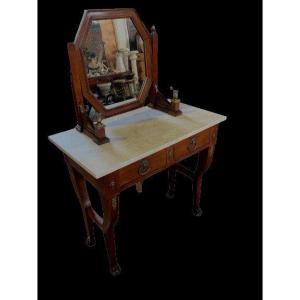A slightly different version of this painting, still from 1879, with a priest present on the right of the scene which does not exist in our version, is in the departmental museum of Quimper, an other version can be seen at Musée d'Orsay in Paris.
This painting, coming from a large Parisian collection, has not undergone any restoration, it is in its original frame which has some chips and small gaps. It measures 57 cm by 46 cm and with the frame 73 cm by 62 cm.
Henry Mosler was born in Eastern Europe and arrived in New York with his parents at the age of 8.
Two years later, the family moved to Cincinnati in a large German Jewish community.
Henry, still a teenager, apprenticed with a wood engraver, Horace C. Grosvenor, and also learned the basics of painting from an amateur landscape painter, Georges Kerr.
From 1859 to 1861 he studied with James Henry Beard and from 1862 to 1863, during the American Civil War, he served as a war correspondent for the weekly Harper's Weekiy.
In 1863, he went to Dusseldorf where for almost three years he studied at the Royal Academy, receiving teaching from Heinrich Mücke and Albert Kindler, then he went to Paris where he studied for 6 months with Ernest Hébert .
He returned to Cincinnati in 1866, where he received numerous commissions for portraits.
After marrying Sara Cahn in 1869 in Cincinnati, Henry Mosler returned to France in 1874.
Then he studied in Munich for 3 years under the direction of Carl Theodor Von Piloty, winning a medal at the Royal Academy.
In 1877 he returned to France where he passed through Pont-Aven. He received a gold medal in Paris in 1888 and in Vienna in 1893, as well as a silver medal at the Paris Salon in 1889. He remained in France until 1894.
He traveled the Pont-Aven region between 1879 and 1884, painting rural scenes with sometimes heightened realism.
Mosler is part of the artistic movement of the end of the 19th century praising rural life.
In 1894 he moved with his family to New York.
He became associated with the American Academy of Design and continued to paint during the first years of the 20th century. He died of a heart attack in 1920 at the age of 78.
It is present in many American museums.
" According to Didier Gouin Breton heritage expert.










































 Le Magazine de PROANTIC
Le Magazine de PROANTIC TRÉSORS Magazine
TRÉSORS Magazine Rivista Artiquariato
Rivista Artiquariato